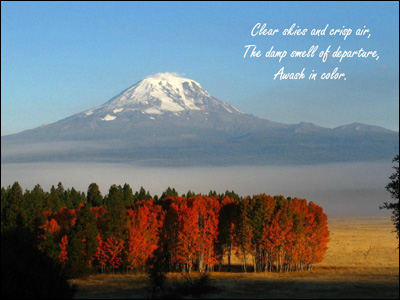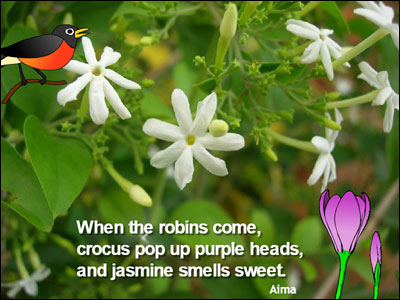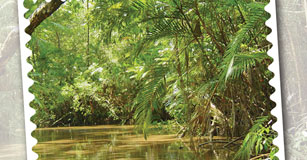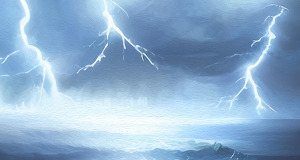Harmonious Haiku
After reading haiku and learning about this short form of Japanese poetry, students will write and illustrate their own haiku poems.

Task
Writing haiku poems can help make you a great author. Haiku poems are short, so they really make you to think about choosing “just right” words. Show off your burgeoning vocabulary by writing and illustrating your own haiku poem.
Engage
Due to their short length, haiku poems are an ideal writing format for hesitant writers and/or students with a language barrier. Writing great haiku is also a great exercise in concise, purposeful word choice, which often prompts rich vocabulary discussions, as students debate author’s word choice and explore multiple meanings and nuance.
Many kids think poetry is boring, so kick off this writing lesson with fun examples of haiku, such as the ones written for boys in Bob Raczka’s Guyku. You might also share examples of entire stories written in haiku, such as Andrew Clements’s Dogku or Lee Wardlaw’s Won Ton: A Cat Tale Told in Haiku.
Ask students what other knowledge and experiences they have with haiku. Clarify that a haiku is a 17-syllable verse form consisting of three metrical units of 5, 7, and 5 syllables. Share an example of a traditional haiku, such as this one from Matsuo Basho, a famous Japanese poet.
An old pond!
A frog jumps in-
The sound of water.
Traditional haiku also contain a kigo, or season word, to indicate in which season the Haiku is set. For example, cherry blossoms would indicate spring and snow would indicate winter.
Work together to count syllables and locate any kigo words in the samples you share.
Wikipedia has a page with a list of Japanese kigo words. While you may not choose to share this list with your students, you may want to explore it on your own and work as a class to create a similar list for each season.
Create
Have individual students choose a season for their poem and begin by brainstorming at least 6 words connected to this season. If you created a list of kigo together, students can refer to your class list. You might also consider grouping students together according to season to come up with their own list of kigo words for their particular season.
Have students refer to the anchor chart you created with key elements of the haiku form or create a worksheet that reminds them of the 5-7-5 syllable pattern, such as the Haiku activity in Wixie.

Word choice is a key element of successful poetry writing. To help build student’s vocabulary and get them thinking about this important part of writing, teach them how to use a thesaurus.
Start by asking students to define synonym. Share a common word like “run” and have students come up with synonyms like: race, jog, skip, or sprint. Use a print or online thesaurus and look up run to see if any additional words are included there.
“The difference between the almost right word and the right word is really a large matter—it's the difference between the lightning bug and the lightning.“
--Mark Twain quoted by George Bainton, The Art of Authorship, 1890.
Have students share the first draft of their haiku with another student. Peer reviewers should identify the kigo or season word, if appropriate, and circle unfamiliar vocabulary words. Student reviewers should also highlight or underline words and phrases that they feel do an excellent job connecting the reader to the meaning of the poem. The intention is to prompt close reading, explanations, and clarifications that the authors can use to improve their poem.

Once students have finished editing their haiku, they can use an authoring tool, such as Wixie, to type their haiku and create support illustrations using the paint tools, photographs, and clip art. Students should also record themselves reading their haiku for intonation and effect.
Share
Print each student’s haiku page in color to display in your classroom. Reach out to a local tea shop or even small business to see if they might be interested in showcasing student work at their site.
Combine individual student pages into one class project. Print the images and bind them into a class book you can share in your library or school media center.
Many photo sharing sites let you easily print coffee-table style books; simply export each students page as a JPG, upload, and choose your print options.
You might also want to host a family or community night where you serve Japanese tea and project the combined student’s haiku pages on a large screen.
Assessment
Evaluate prior knowledge about haiku as poetry form as you read a haiku book or share other samples with the class. Evaluate their understanding of syllables as you clap and read the haiku, as well as in one-on-one conversations as students write their own haiku. You will be able to use these conversations to get a sense of the size of a student’s vocabulary and word choice writing skills.
Share a rubric or checklist to clarify your expectations for their work.
As they develop the backgrounds and supporting artwork in Wixie, ask questions and engage in additional one-on-one dialog that gets students to explain their choices, helping you evaluate comprehension. Their recording, and practice before recording, will help build and assess reading fluency.
Resources
Bob Raczka. GUYKU: A Year of Haiku for Boys. ISBN: 0547240031
Andrew Clements. Dogku. ISBN: 068985823X
Lee Wardlaw. Won Ton: A Cat Tale Told in Haiku. ISBN: 0805089950
Laya Steinberg. Thesaurus Rex. ISBN: 1841481807
Standards
Common Core State Standards for English Language Arts:
CCSS.ELA-LITERACY.W.2.3
Write narratives in which they recount a well-elaborated event or short sequence of events, include details to describe actions, thoughts, and feelings, use temporal words to signal event order, and provide a sense of closure.
CCSS.ELA-LITERACY.W.2.5
With guidance and support from adults and peers, focus on a topic and strengthen writing as needed by revising and editing.
CCSS.ELA-LITERACY.W.2.6
With guidance and support from adults, use a variety of digital tools to produce and publish writing, including in collaboration with peers.
CCSS.ELA-LITERACY.SL.2.5
Create audio recordings of stories or poems; add drawings or other visual displays to stories or recounts of experiences when appropriate to clarify ideas, thoughts, and feelings.
CCSS.ELA-LITERACY.L.2.1.E
Use adjectives and adverbs, and choose between them depending on what is to be modified.
CCSS.ELA-LITERACY.W.3.3
Write narratives to develop real or imagined experiences or events using effective technique, descriptive details, and clear event sequences.
CCSS.ELA-LITERACY.W.3.4
With guidance and support from adults, produce writing in which the development and organization are appropriate to task and purpose.
CCSS.ELA-LITERACY.W.3.5
With guidance and support from peers and adults, develop and strengthen writing as needed by planning, revising, and editing.
CCSS.ELA-LITERACY.W.3.6
With guidance and support from adults, use technology to produce and publish writing (using keyboarding skills) as well as to interact and collaborate with others.
CCSS.ELA-LITERACY.SL.3.5
Create engaging audio recordings of stories or poems that demonstrate fluid reading at an understandable pace; add visual displays when appropriate to emphasize or enhance certain facts or details.
CCSS.ELA-LITERACY.L.3.3.A
Choose words and phrases for effect.
CCSS.ELA-LITERACY.W.4.3
Write narratives to develop real or imagined experiences or events using effective technique, descriptive details, and clear event sequences.
CCSS.ELA-LITERACY.W.4.3.D
Use concrete words and phrases and sensory details to convey experiences and events precisely.
CCSS.ELA-LITERACY.W.4.4
Produce clear and coherent writing in which the development and organization are appropriate to task, purpose, and audience.
CCSS.ELA-LITERACY.W.4.5
With guidance and support from peers and adults, develop and strengthen writing as needed by planning, revising, and editing.
CCSS.ELA-LITERACY.SL.4.5
Add audio recordings and visual displays to presentations when appropriate to enhance the development of main ideas or themes.
CCSS.ELA-LITERACY.L.4.3.A
Choose words and phrases to convey ideas precisely.
ISTE NETS for Students 2016:
6. Creative Communicator
Students communicate clearly and express themselves creatively for a variety of purposes using the platforms, tools, styles, formats and digital media appropriate to their goals. Students:
a. choose the appropriate platforms and tools for meeting the desired objectives of their creation or communication.
b. create original works or responsibly repurpose or remix digital resources into new creations.
d. publish or present content that customizes the message and medium for their intended audiences.








